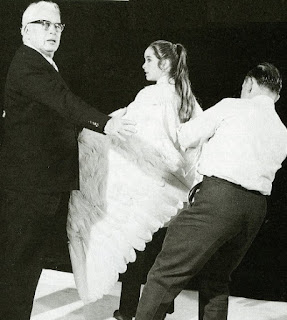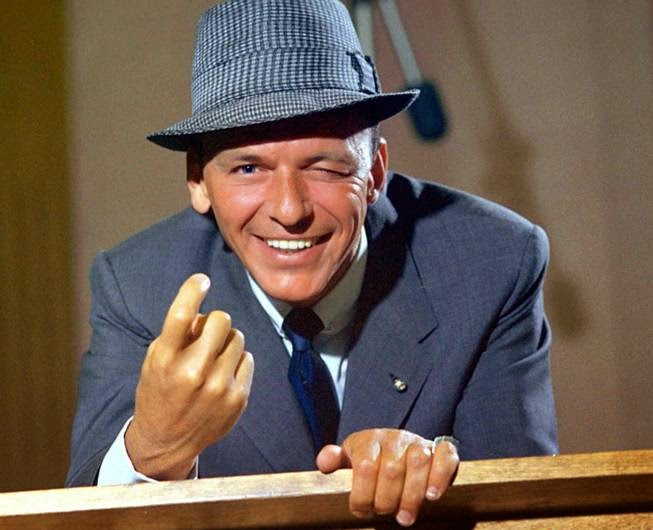 |
| Christopher Lee |
Legendary actor Christopher Lee died of heart failure on June 7th at the age of 93. He was an English actor, singer and author. With a career spanning nearly 70 years, Lee initially portrayed villains and became best known for his role as Count Dracula in a sequence of Hammer Horror films. Lee's first film for Hammer was The Curse of Frankenstein (1957), in which he played Frankenstein's monster, with Peter Cushing as Baron Victor Frankenstein. It was the first film in which Lee and Cushing were co-stars, and ultimately appeared together in over twenty films and became close friends.His other film roles include Francisco Scaramanga in the James Bond film The Man with the Golden Gun (1974), Saruman in The Lord of the Rings film trilogy (2001–2003) and The Hobbit film trilogy (2012–2014), and Count Dooku/Darth Tyranus in the final two films of the Star Wars prequel trilogy (2002 and 2005) and Star Wars: The Clone Wars (2008).
Television actor Al Molinaro died on October 30th at the age of 96. He was known for his television sitcom roles as Al Delvecchio on Happy Days from 1974 to 1984 and Murray Greshler on The Odd Couple from 1970-1975. He also starred in TV commercials for On-Cor frozen dinners for 16 years.
Television actress Marjorie Lord died on November 28th at the age of 97. She played Kathy "Clancy" Williams, opposite Danny Thomas's character on Make Room for Daddy from 1956 to 1964 and later Make Room for Granddaddy from 1970 to 1971.She also appeared sporadically in movies, and she played opposite Bob Hope in the comedy Boy, Did I Get A Wrong Number in 1966.
 |
| Leonard Nimoy |
Actor Leonard Nimoy died of chronic obstructive pulmonary disease on February 27th at the age of 83. In 1965, he made his first appearance in the rejected Star Trek pilot The Cage, and went on to play the character of Mr. Spock until 1969, followed by eight feature films and guest slots in the various spin-off series. More recently, he also had a recurring role in the science fiction series Fringe. He played the elder Spock in the 2009 Star Trek movie and reprised the role in a brief appearance in the 2013 sequel, Star Trek Into Darkness.
Actor Louis Jourdan died on February 14 at the age of 93. He was a French film and television actor. He was known for his suave roles in several Hollywood films, including The Paradine Case (1947), Letter from an Unknown Woman (1948), Gigi (1958), The Best of Everything (1959), The V.I.P.s (1963) and Octopussy (1983).
Television actress Donna Douglas died at the age of 81 on January 1st of pancreatic cancer. She was known for her role as Elly May Clampett in CBS's The Beverly Hillbillies (1962–1971). Following her acting career, Douglas became a real estate agent, a Gospel singer and inspirational speaker, and authored books for children and adults.
Director and writer Wes Craven died on August 30th at the age of 76. He was best known for creating the A Nightmare on Elm Street franchise featuring the Freddy Krueger character, directing the first installment and Wes Craven's New Nightmare, and co-writing A Nightmare on Elm Street 3: Dream Warriors with Bruce Wagner. Craven also directed all four films in the Scream series, and co-created the Ghostface character. Some of his other films include The Hills Have Eyes, The Last House on the Left, Red Eye and My Soul to Take.
Singer and actress Monica Lewis died at the age of 93 on June 12th. With the help of Benny Goodman she began to establish her career through nationally broadcast shows such as The Revere Camera Show and Beat the Band. In 1947 Lewis started providing the singing voice for "Miss Chiquita Banana," a cartoon television commercial character. In 1948 she appeared in the first ever Ed Sullivan Show, and she later appeared in some 1970s disaster films such as Earthquake (1974), Rollercoaster (1977), and both Airport '77 (1977) and The Concorde ... Airport '79 (1979).
 |
| Joan Leslie |
Actress Joan Leslie died on October 12, 2015 at the age of 90. She was a dancer and vaudevillian who, during the Hollywood Golden Age, appeared in such films as High Sierra (1941) , Sergeant York (1941) and Yankee Doodle Dandy (1942) - all before the age of 20. Her last film was The Revolt of Mamie Stover in 1956, but she remained active in appearances at various classic movie conventions.
Movie producer Samuel Goldwyn Jr. died of heart failure at the age of 88 on January 9th. Mr. Goldwyn was credited with giving Julia Roberts her big break in Mystic Pizza in 1988. His final producing credit came in December of 2013 with the release of The Secret Life of Walter Mitty, starring and directed by Ben Stiller, a remake of one of his father’s biggest hits. His father was studio mogul Samuel Goldwyn (1879-1974).
Singer Lesley Gore died of cancer on February 16th at the age of 68. At the age of 16, in 1963, she recorded the pop hit "It's My Party", and followed it up with other hits including "Judy's Turn to Cry" and "You Don't Own Me". Gore also worked as an actress and composed songs with her brother Michael Gore for the 1980 film Fame, for which she was nominated for an Academy Award.
Actor James Best died of pneumonia at the age of 88 on April 6th. He was an American actor, who in six decades of television is best known for his starring role as bumbling Sheriff Rosco P. Coltrane in the CBS television series The Dukes of Hazzard from 1979 to 1985. He also worked as an acting coach, artist, college professor, and musician. His last role was in the TV movie, The Sweeter Side of Life in a 2013.
Sex symbol Anita Ekberg died of undisclosed causes on January 11th at the age of 83. Anita was a Swedish-born Italian actress, model, and sex symbol. She is best known for her role as Sylvia in the Federico Fellini film La Dolce Vita (The Sweet Life, 1960), which features a scene of her cavorting in Rome's Trevi Fountain alongside Marcello Mastroianni.
Actress Coleen Gray died on August 3rd at the age of 92. She was best known for her roles in the films Nightmare Alley (1947), Red River (1948), and Stanley Kubrick's The Killing (1956). A film noir beauty, she could also play light hearted roles like the role of Bing Crosby's love interest in the 1950 Frank Capra musical Riding High.
Actor Gary Owens died at the age of 80 on February 12th. He will be best remembered as the announcer for the TV series "Rowan and Martin's Laugh-In" from 1968 to 1973. His popularity and distinctive voice was suited well for animated TV programs such as "Space Ghost" (1966), "Yogi's Space Race" (1978), as well as many others.
 |
| Lizabeth Scott |
Actress Lizabeth Scott died of heart failure at the age of 92 on January 31st. Scott was known for her deep voice and smoky sensual looks. After performing the Sabina role in the first Broadway and Boston stage productions of The Skin of Our Teeth, she emerged internationally in such film noirs as The Strange Love of Martha Ivers (1946), Dead Reckoning (1947) Desert Fury (1948) and Too Late for Tears (1949). No other actress has appeared in more film noir. Of her 22 feature films, she was leading lady in all but one. In addition to stage and radio, she appeared on television from the late 1940s to early 1970s.
Character actor Robert Loggia died on December 4th. He was nominated for the Academy Award for Best Supporting Actor for Jagged Edge (1985). Other notable appearances include An Officer and a Gentleman (1982), Scarface (1983), Prizzi's Honor (1985), Big (1988), Independence Day (1996), and Lost Highway (1997), as well as television series such as The Sopranos. Despite suffering from Alzheimer's Disease, Loggia continued to make movies through this year.
Actress Anne Meara died on May 23rd at the age of 85. Along with her husband Jerry Stiller, she was half of the Stiller and Meara comedy team. They gained national attention during the 1960s with the aid of numerous appearances on "The Ed Sullivan Show". Highly versatile, she experienced an extensive career on stage and was the recipient of an Obie Award for her performance in "Madchen in Uniform" (1955). She was the mother of actress Amy Stiller and actor Ben Stiller.
Actor Dean Jones died at the age of 84 on September 1st. Jones was an American actor best known for his light-hearted leading roles in several Walt Disney films between 1965 and 1977, such as The Love Bug (1968). Jones also originated the role of Bobby in Stephen Sondheim's Company. Jones also appeared in a small role as Director of Central Intelligence Judge Arthur Moore in the film adaptation of Tom Clancy's Clear and Present Danger (1994), which starred Harrison Ford.
Music producer and historian Ken Barnes died on August 4th at the age of 82. Ken produced a series of successful records that Bing Crosby made in the 1970s. In 1974, he convinced Johnny Mercer to record a two-disk collection of Mercer singing Mercer - with Johnny selecting his own favorites. These were the last recordings made by Mercer before his death in 1976. He was also the founder and CEO of The Laureate Company, a music and movie restoration company.
 |
| Maureen Stapleton |
Actress Maureen O'Hara died at the age of 95 on October 24th. From an early age, she wanted to become an actress and took lessons. She was given a screen test, which was deemed unsatisfactory, but Charles Laughton saw something in her when he later saw it. He arranged for her to co-star with him in the Alfred Hitchcock 1939 British film Jamaica Inn. She also co-starred with him in the Hollywood production of The Hunchback of Notre Dame, released the same year. She made a number of films with John Wayne – the actor with whom she is most closely associated – and director John Ford, often both together in the same production, including The Quiet Man (1952). She also starred in swashbucklers such as The Black Swan (1942), opposite Tyrone Power, and Sinbad the Sailor (1947), with Douglas Fairbanks, Jr., as well as the Christmas classic Miracle on 34th Street (1947), with John Payne, Natalie Wood, and Edmund Gwenn.
May these great entertainers and all of the people we have lost in 2015 rest in peace and may their contributions to the world never be forgotten...




































_01.jpg)











